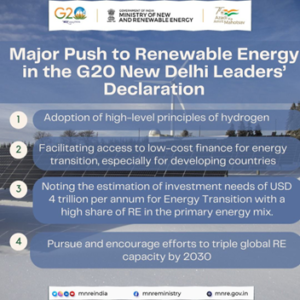India’s Climate Goals Demand More Clean Energy.
Relevance
- GS 3: Conservation, Environmental Pollution and Degradation.
- Tags: #ClimateChange #RenewableEnergy #IndiaClimateAction #UPSC #MintEditorial.
Why in the News?
India’s population surpassed that of any other nation, and Prime Minister Narendra Modi pledged a unique approach, emphasizing global unity and addressing climate change. However, India’s green commitments face challenges, raising questions about its climate leadership potential.
Green Rhetoric Fades at G20
- While India’s Prime Minister Narendra Modi initially emphasized global unity and climate change as crucial challenges during its G20 presidency, the green rhetoric seemed quiet during the recent G20 leaders’ summit.
- Despite the promising theme of ‘Vasudhaiva kutumbakam,’ and addressing climate issues, the focus and discussions at the summit appeared to have shifted, raising questions about the prioritization of environmental concerns on the global stage.
Focus on Lifestyle Changes Over Renewable Energy Targets
- Shift in Focus: PM Modi discussed issues like a failed plastic bag ban and global lifestyle changes, such as reducing food waste and conserving water, rather than highlighting India’s ambitious renewable energy goals.
- Missing Renewable Energy Target: Absent was any mention of India’s target to achieve 500 gigawatts of renewable energy capacity by 2030.
- Diplomatic Language: PM Modi emphasized that there are “no one-size-fits-all solutions” (no universal solutions) and that different countries will have distinct paths for energy transition.
- Subdued Climate Rhetoric: The statements suggest a shift in India’s climate rhetoric, with less emphasis on green initiatives and more on lifestyle changes and localized solutions.
Challenges in India’s Energy Mix and Climate Responsibility
Monsoon Season Impact
- Due to the hot and dry weather, 7% to 9% of households have air conditioning, and farmers have turned on groundwater irrigation pumps, increasing demand from the grid to a record 240 gigawatts on September 1.
Record Coal Consumption
- In response to the heightened electricity demand, India’s coal consumption in August rose by 13% compared to the previous year, reaching nearly 68 million tonnes.
- This increase in coal usage is a result of the strain on the grid caused by the monsoon-related factors and a shortage of hydroelectric power and renewable energy sources.
Climate Responsibility
- India, despite its current reliance on coal, is not the primary contributor to global climate issues.
- India’s historic greenhouse gas emissions account for just 3% of the global total.
- On a per-capita basis, India’s emissions are significantly lower than those of the European Union (EU) and the United States (US).
Air Conditioning Necessity
- The rise in air conditioning use in India is depicted as a survival necessity, particularly in the context of global warming.
- As the planet experiences increasing temperatures, access to air conditioning is seen as essential for comfort and health, especially in a country where extreme heat events are becoming more frequent.
Political Considerations
- With general elections on the horizon, power cuts are not an option.
- This suggests that maintaining a stable electricity supply is a critical political concern for the government, even in the face of environmental challenges.
Unfulfilled Renewable Energy Targets
- In 2015, Prime Minister Modi set a goal to achieve 175 gigawatts of renewable energy capacity by 2022 in India.
- However, as of the recent assessment, only approximately 60% of the promised capacity was actually added.
- To bridge the gap, the government included nuclear, large hydro, and under-construction generators in the count, which allowed them to approach the total target.
- The Indian government aims to install 500 gigawatts of zero-carbon power by 2030, requiring an annual addition of 50 gigawatts.
- However, cumulative installations from late 2019 to mid-2023 have reached only about 40 gigawatts.
- In the first five months of 2023, only 4.8 gigawatts were added, suggesting a potentially weak year compared to 2020.
Challenges in India’s Renewable Energy Sector
The challenges faced by India in achieving its renewable energy goals are multi-faceted
- Global Interest Rates Impact: The cost of financing energy infrastructure has risen due to global interest rates, making it more challenging to fund renewable energy projects in India.
- Land Ownership Complexity: India’s chaotic land ownership system has led to opposition against solar and transmission projects, hindering their development.
- Counterproductive Import Tax: A planned 40% import tax on solar modules is set to increase the cost of renewable power rather than promoting domestic manufacturing.
- Uncertainty over Tariffs and Components: Uncertainties surrounding power tariffs, approved components, and project timelines have contributed to a significant 58% Year-on- Year decline in solar installations in the June quarter, as reported by Mercom India Research.
- Positive Wind Energy Market: In contrast, wind energy has seen a 165% increase in connections during the same period, driven by regulations mandating increased power purchases from wind turbines.
While India’s renewable energy sector faces challenges, favorable policies, as seen in the wind energy segment, continue to support growth in the market.
Energy Transition: India Lags Behind
- In 2023, the global energy transition is thriving, with China set to install an impressive 209 gigawatts of solar power, while plug-in electric cars achieved a remarkable 38% market share in July.
- In contrast, India lags behind with only a 5.5% market share for electric vehicles and a mere 8,738 public charging stations.
- The Confederation of Indian Industry anticipates a need for 1.32 million charging stations by 2030 to meet growing demand
India, with its potential for cheap renewables, could become a climate leader. However, it now has the world’s third-largest carbon footprint after China and the US, surpassing the EU. To truly fulfill this potential, Prime Minister Modi must ensure words are backed by substantial actions to address this growing carbon challenge over the next decade.
Source: Livemint
Mains Question
Discuss the challenges India is facing in achieving its target of installing 500 gigawatts of renewable energy by 2030. What factors contribute to this challenge?






